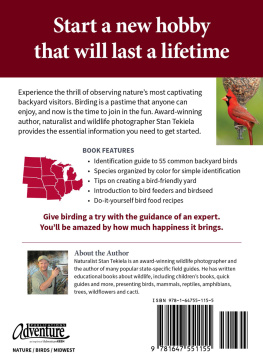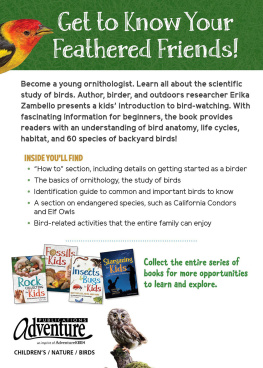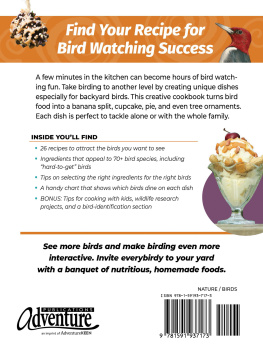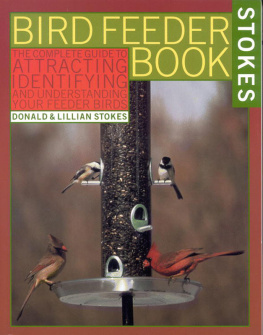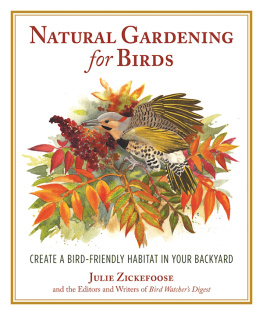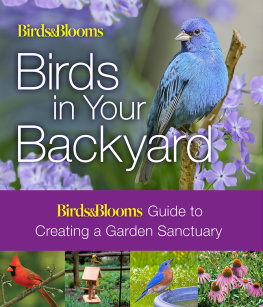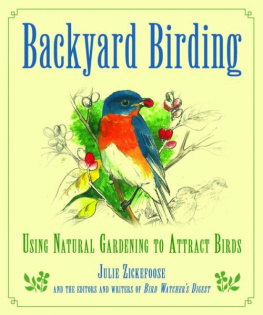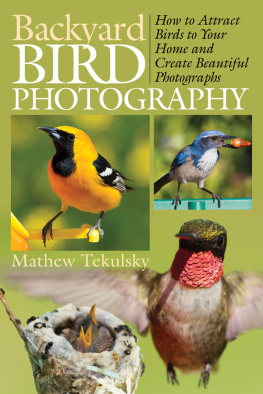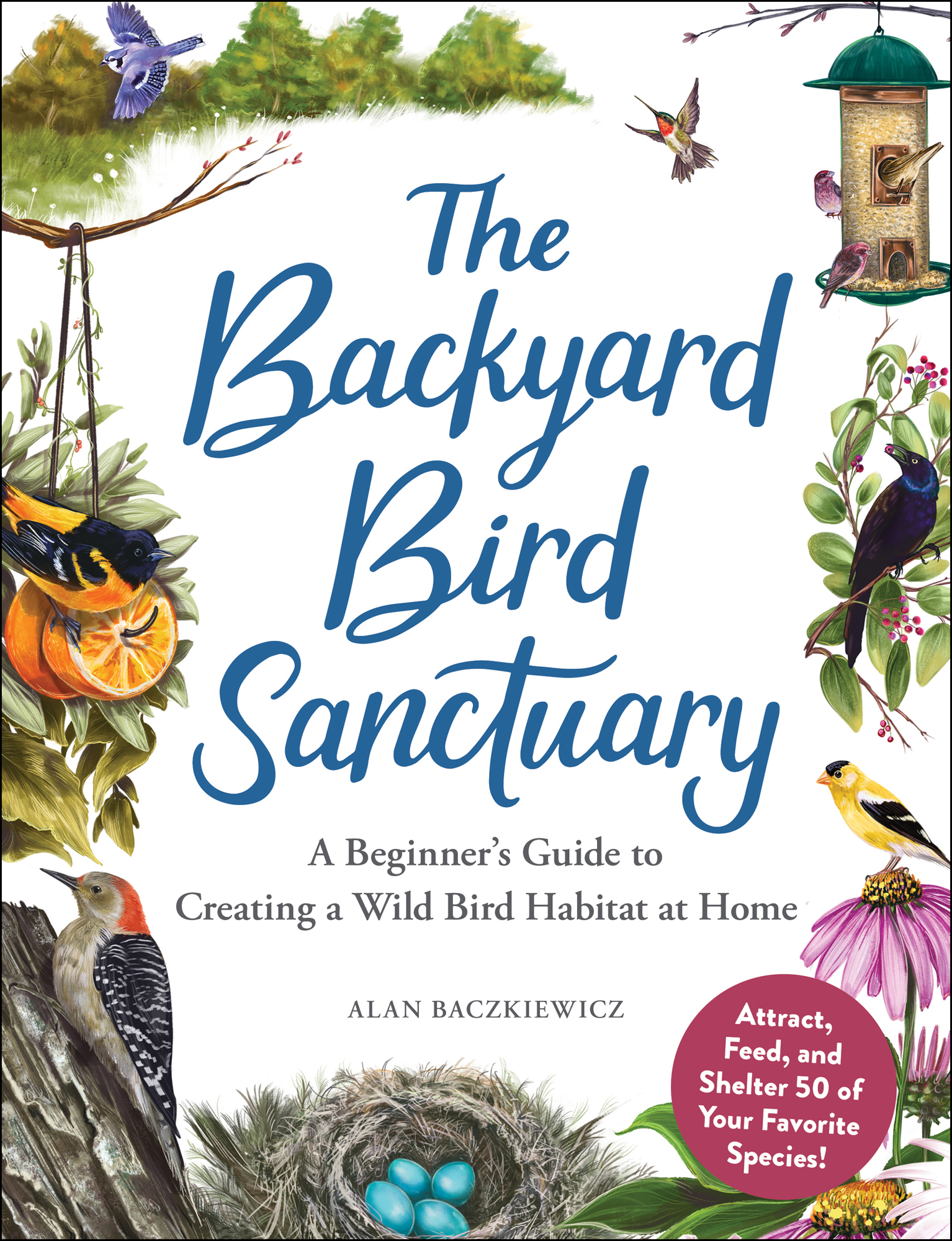Contents
Guide
The Backyard Bird Sanctuary
A Beginners Guide to Creating a Wild Bird Habitat at Home
Alan Baczkiewicz
Attract, Feed, and Shelter 50 of Your Favorite Species!
Dedication
To my dad, who shared his time with me on birding walks and listened to a sons dreams.
Introduction
Welcome to the wonderful world of birding! You have just joined the fifty-seven million households in the US that also attract, watch, and feed birds. Bird-watching is a hobby that allows you to enjoy the outdoors during all seasons no matter where you live. Hearing familiar bird songs throughout the day will be like listening to friends voices. After a year, you will welcome old friends back to the feeder and will be amazed at how many different species of birds visit your yard.
The Backyard Bird Sanctuary helps you learn to identify the fifty most common species of birds that visit feeders or nest in backyards throughout the US. The quality of the food, water features, and nesting opportunities that you provide will determine what birds visit your backyard. It does not matter whether you live in the country with acres of land or in an urban metropolis with a small backyard; you can attract birds. This guide will be a valuable source of information wherever you call home: the East Coast, the West Coast, or somewhere in between. The majority of the birds included in this book are found across the US, while some are found in more particular locales.
In Part 1, youll learn the basics of attracting birds to your backyard: what to feed them, what kinds of feeders to choose from, and what sources of water birds like for drinking and for birdbaths, as well as advice on keeping your birding environment clean and healthy for our feathered friends. Youll also find information on shelter, including protective shelter and nesting information. Included in this part is a list of terms used in this book.
In Part 2, youll find profiles of the fifty most common backyard birds from across the country. Each entry gives a description of the identifying field marks, as well as illustrations of the males and females (when males and females are identical in appearance, only one illustration is given). Youll also find information on the range where the bird can be found, followed by migration information that tells you when you can see the bird in a certain locale. Next, the entry lists preferred types of food eaten by that species and the particular feeder type you will needimportant, since you want to attract a wide range of birds to your feeder. Many of the birds described in the book may nest in your yard, using either a nest theyve constructed or a nest box you have provided. The entry gives a description of the natural nest and each species egg in case you would like to know who the owner is. You will also get the details needed to make and place a nest box for particular species. Specific tips on attracting a species along with any other important information close each entry.
Now that you have this information, youre ready to plan which birds you want to visit your feeding stations, and youve got the information to readily identify them.
Its time to start bird-watching!
PART 1 How to Attract Birds to Your Yard
Attracting birds to your yard will take a little effort and some patience, but over a weekend you can set up very basic feeding and watering components. This does not need to be an expensive venture; you can choose to repurpose items or purchase specialized feeders and baths depending on your budget. If you like, you can also attract birds by providing shelter in the form of birdhouses during the nesting months. By using the information in The Backyard Bird Sanctuary, youll have the confidence to reimagine your own backyard as a haven for birds. Whatever degree of interest you have in your local feathered friends, you are sure to start a lifelong hobby in bird-watching.
Types of Food
The type of food you provide will determine which birds come to your backyard. There are ten main types of food you can purchase to place in feeders in your yard. Some of these are specific to one type of bird. Nectar, for example, is only for hummingbirds. Other types of food are eaten by a variety of birds. The types of seed you use is based on what birds you want to attract to your yard and the budget you have for feeding them. A list of each species preferred food is provided in its entry so you can quickly determine what types of food you should have on hand for whichever type of bird you want to attract.
Sunflower
While not the most common seed in regular wild birdseed mix, sunflower seeds are one of the best because they will attract many birds. The best variety to go with is black oil sunflower seed since it has a thinner hull and supplies more calories per seed for birds. When buying sunflower seed, you have a choice between regular and hulled seed. If you dont want to have a lot of seed waste under your feeders, you can upgrade to the hulled variety. Birds do not eat the whole seed; they remove the kernel from the hull (or outside coating), which then falls to the ground.
Safflower
Safflower is similar to, but smaller than, sunflower seed and has a hull that is harder to remove. This characteristic may discourage some of the more aggressive birds, such as blackbirds and starlings, from eating it. This allows cardinals and finches to gather at the feeder and have a food they enjoy.
Cracked Corn
Another common and inexpensive food is cracked corn. This will attract many of the ground feeders in your area, such as doves, sparrows, juncos, and so on. No feeders are needed; you simply scatter the corn on the ground where you would like to attract the birds. For some smaller birds, this may be near shrubbery or a brush pile.
Nyjer Seed
Another common food is thistle, or Nyjer seed. This seed is the favorite food of the finches. The seed is very small and requires a specialized tube feeder. The feeder has a much smaller opening for the seed to be extracted from the tube. Nyjer seed is a little more expensive, but it will last longer because only the finches will be able to access and eat it.
Suet


